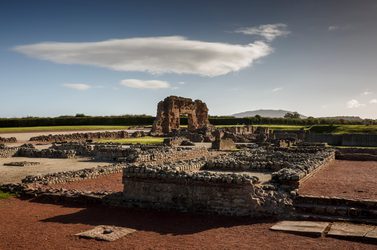- Myths, Legends and Folktales of Shropshire
- The Sparrows of Wroxeter: The Birds That Dismantled a City
The Sparrows of Wroxeter: The Birds That Dismantled a City

Long before the Normans, the Vikings – even before the Saxons! – Romans came to Shropshire.
Almost 2000 years ago, the Cornovii tribe lived on the land, in a quiet little place nestled under the Wrekin that we now call Wroxeter. They farmed, traded, and lived in houses made of wood and leather.
But when the Romans came, everything changed. They built a fortress and renamed the land Viroconium. Within a generation, the Cornovii way of life was swept away by Roman roads, coins, laws, bronze tools, and stone buildings.
By AD 80, the city had grown big enough to cover about 110 football pitches! It had all the modern conveniences, too: market hall, bath house, shops, a temple, and courts (sounds like Roman Shrewsbury!). By AD 90, Viroconium wasn’t just any official Roman city – it was one of the largest in Britain.
For around 300 years, Viroconium remained an important place, where people lived, worked, and travelled.
But as the Roman Empire began to crumble, cities far away from Rome had to fend for themselves. Without the support of taxes, Viroconium’s roads and buildings began to crumble, too – and the people left. Over time, the bustling city was silenced.
But some Viroconium residents didn’t go far. Instead of leaving for distant lands, these people founded their own village close to the River Severn. And what happened to that little village? It became Wroxeter.
As centuries passed, people began to whisper: How did the great city of Viroconium disappear?
There had once been great walls and buildings made of stone, something much longer lasting than the timber buildings preferred by locals. Where could the impressive buildings have gone, if they weren’t eaten up by time?
Well, according to legend, the answer was simple: Sparrows.
You see, the locals would tell you, one evening, the biggest flock of sparrows you’d ever seen descended on Viroconium! Thousands of them, all working together, to pick apart the buildings for supplies to make their nests. They took the tiles, the walls, the mosaics, and every statue.
By morning, the city was simply gone – carried away in a cloud of feathers.
Of course, the real story is more likely to be about people carrying away the stones to build their new village – but over a period far longer than a single night. And just like, one by one, they carried away the stones of Viroconium, one by one their children and grandchildren forget where the stones had come from.
But who really knows? Half of ancient history is debate. If you choose to believe in the sparrows of Wroxeter, we won’t tell you otherwise.

Image courtesy Visit Shropshire
